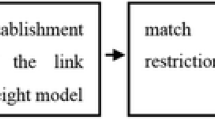Abstract
Interactive video segmentation has become a popular topic in computer vision and computer graphics. Discrete optimization using maximum flow algorithms is one of the preferred techniques to perform interactive video segmentation. This paper extends pixel based graph cut approaches to overcome the problem of high memory requirements. The basic idea is to use a graph cut optimization framework on top of temporally coherent superpixels. While grouping spatially coherent pixels sharing similar color, these algorithms additionally exploit the temporal connections between those image regions. Thereby the number of variables in the optimization framework is severely reduced. The effectiveness of the proposed algorithm is shown quantitatively, qualitatively and through timing comparisons of different temporally coherent superpixel approaches. Experiments on video sequences show that temporally coherent superpixels lead to significant speed-up and reduced memory consumption. Thus, video sequences can be interactively segmented in a more efficient manner while producing better segmentation quality when compared to other approaches.
Access this chapter
Tax calculation will be finalised at checkout
Purchases are for personal use only
Preview
Unable to display preview. Download preview PDF.
Similar content being viewed by others
References
Wang, S., Lu, H., Yang, F., Yang, M.H.: Superpixel tracking. In: ICCV, pp. 1323–1330 (2011)
Wang, J., Xu, Y., Shum, H.Y., Cohen, M.F.: Video tooning. In: SIGGRAPH, pp. 572–581 (2004)
van den Hengel, A., Dick, A., Thormählen, T., Ward, B., Torr, P.H.: Videotrace: rapid interactive scene modelling from video. In: SIGGRAPH, vol. 26 (2007)
Reso, M., Jachalsky, J., Rosenhahn, B., Ostermann, J.: Temporally consistent superpixels. In: ICCV, pp. 385–392 (2013)
Boykov, Y., Jolly, M.P.: Interactive graph cuts for optimal boundary & region segmentation of objects in nd images. In: ICCV, vol. 1, pp. 105–112 (2001)
Rother, C., Kolmogorov, V., Blake, A.: Grabcut: Interactive foreground extraction using iterated graph cuts. In: SIGGRAPH, vol. 23, pp. 309–314 (2004)
Delong, A., Boykov, Y.: A scalable graph-cut algorithm for nd grids. In: CVPR, pp. 1–8 (2008)
Scheuermann, B., Schlosser, M., Rosenhahn, B.: Efficient pixel-grouping based on dempster’s theory of evidence for image segmentation. In: Lee, K.M., Matsushita, Y., Rehg, J.M., Hu, Z. (eds.) ACCV 2012, Part I. LNCS, vol. 7724, pp. 745–759. Springer, Heidelberg (2013)
Ren, X., Malik, J.: Learning a classification model for segmentation. In: ICCV, pp. 10–17 (2003)
Galasso, F., Cipolla, R., Schiele, B.: Video segmentation with superpixels. In: ACCV 2013, pp. 760–774 (2013)
Vazquez-Reina, A., Avidan, S., Pfister, H., Miller, E.: Multiple hypothesis video segmentation from superpixel flows. In: Daniilidis, K., Maragos, P., Paragios, N. (eds.) ECCV 2010, Part V. LNCS, vol. 6315, pp. 268–281. Springer, Heidelberg (2010)
Grundmann, M., Kwatra, V., Han, M., Essa, I.: Efficient hierarchical graph-based video segmentation. In: CVPR, pp. 2141–2148 (2010)
Chang, J., Wei, D., Fisher III, J.W.: A video representation using temporal superpixels. In: CVPR, pp. 2051–2058 (2013)
Bergh, M.V.D., Roig, G., Boix, X., Manen, S., Gool, L.V.: Online video seeds for temporal window objectness. In: ICCV, pp. 377–384 (2013)
Xu, C., Whitt, S., Corso, J.J.: Flattening supervoxel hierarchies by the uniform entropy slice. In: ICCV, pp. 2240–2247 (2013)
Wang, J., Bhat, P., Colburn, R.A., Agrawala, M., Cohen, M.F.: Interactive video cutout. SIGGRAPH 24, 585–594 (2005)
Price, B.L., Morse, B.S., Cohen, S.: Livecut: Learning-based interactive video segmentation by evaluation of multiple propagated cues. In: ICCV, pp. 779–786 (2009)
Bai, X., Wang, J., Simons, D., Sapiro, G.: Video snapcut: robust video object cutout using localized classifiers. SIGGRAPH 28 (2009)
Dondera, R., Morariu, V., Wang, Y., Davis, L.: Interactive video segmentation using occlusion boundaries and temporally coherent superpixels. In: WACV, pp. 784–791 (2014)
Levinshtein, A., Sminchisescu, C., Dickinson, S.: Spatiotemporal closure. In: Kimmel, R., Klette, R., Sugimoto, A. (eds.) ACCV 2010, Part I. LNCS, vol. 6492, pp. 369–382. Springer, Heidelberg (2011)
Lermé, N., Malgouyres, F., Létocart, L.: Reducing graphs in graph cut segmentation. In: ICIP, pp. 3045–3048 (2010)
Scheuermann, B., Rosenhahn, B.: SlimCuts: GraphCuts for high resolution images using graph reduction. In: Boykov, Y., Kahl, F., Lempitsky, V., Schmidt, F.R. (eds.) EMMCVPR 2011. LNCS, vol. 6819, pp. 219–232. Springer, Heidelberg (2011)
Achanta, R., Shaji, A., Smith, K., Lucchi, A., Fua, P., Susstrunk, S.: Slic superpixels compared to state-of-the-art superpixel methods. TPAMI 34, 2274–2282 (2012)
Reso, M., Jachalsky, J., Rosenhahn, B., Ostermann, J.: Superpixels for video content using a contour-based em optimization. In: ACCV (2014)
Boykov, Y., Kolmogorov, V.: An experimental comparison of min-cut/max-flow algorithms for energy minimization in vision. TPAMI 26, 1124–1137 (2004)
Sundberg, P., Brox, T., Maire, M., Arbelaez, P., Malik, J.: Occlusion boundary detection and figure/ground assignment from optical flow. In: CVPR (2011)
Galasso, F., Nagaraja, N.S., Cárdenas, T.J., Brox, T., Schiele, B.: A unified video segmentation benchmark: Annotation, metrics and analysis. In: ICCV, pp. 3527–3534 (2013)
Comaniciu, D., Meer, P.: Mean shift: A robust approach toward feature space analysis. TPAMI 24, 603–619 (2002)
Blake, A., Rother, C., Brown, M., Perez, P., Torr, P.: Interactive image segmentation using an adaptive GMMRF model. In: Pajdla, T., Matas, J(G.) (eds.) ECCV 2004. LNCS, vol. 3021, pp. 428–441. Springer, Heidelberg (2004)
Author information
Authors and Affiliations
Editor information
Editors and Affiliations
Rights and permissions
Copyright information
© 2014 Springer International Publishing Switzerland
About this paper
Cite this paper
Reso, M., Scheuermann, B., Jachalsky, J., Rosenhahn, B., Ostermann, J. (2014). Interactive Segmentation of High-Resolution Video Content Using Temporally Coherent Superpixels and Graph Cut. In: Bebis, G., et al. Advances in Visual Computing. ISVC 2014. Lecture Notes in Computer Science, vol 8887. Springer, Cham. https://doi.org/10.1007/978-3-319-14249-4_27
Download citation
DOI: https://doi.org/10.1007/978-3-319-14249-4_27
Publisher Name: Springer, Cham
Print ISBN: 978-3-319-14248-7
Online ISBN: 978-3-319-14249-4
eBook Packages: Computer ScienceComputer Science (R0)




